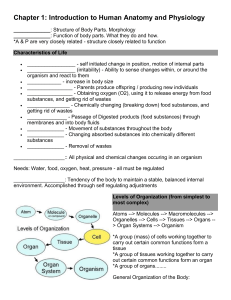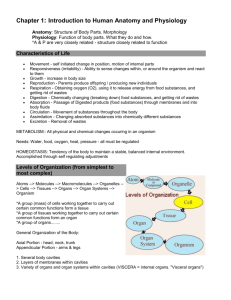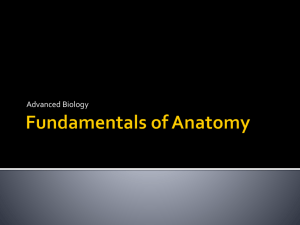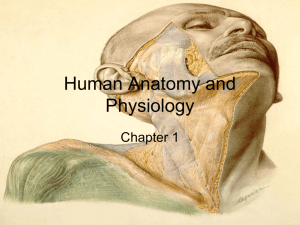File
advertisement
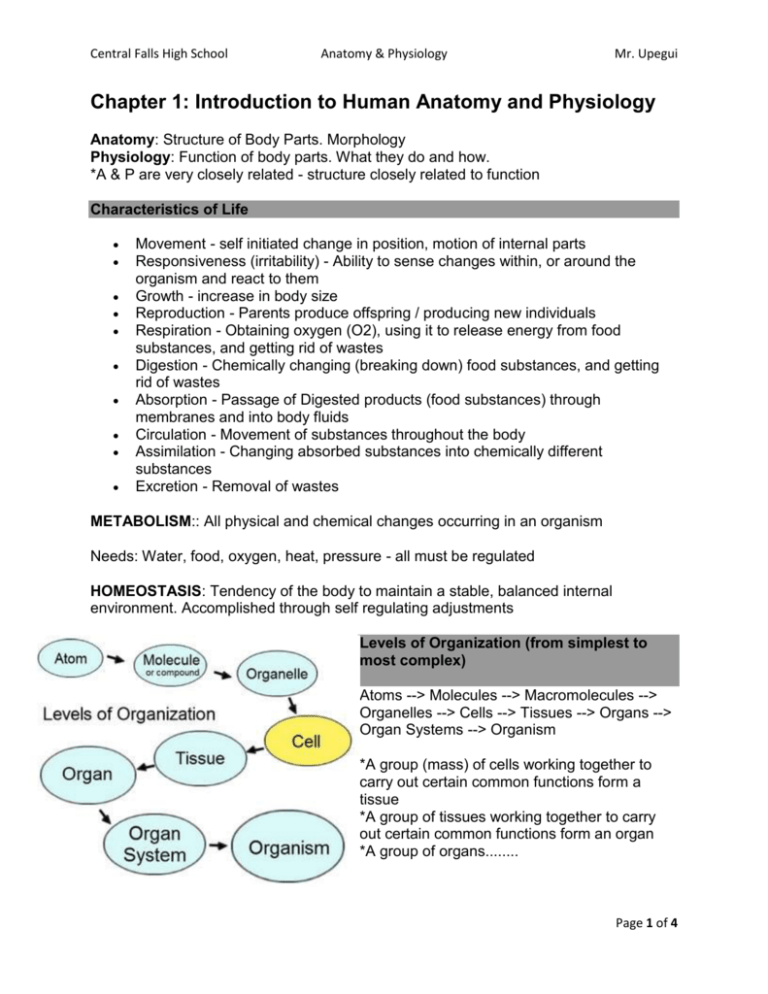
Central Falls High School Anatomy & Physiology Mr. Upegui Chapter 1: Introduction to Human Anatomy and Physiology Anatomy: Structure of Body Parts. Morphology Physiology: Function of body parts. What they do and how. *A & P are very closely related - structure closely related to function Characteristics of Life Movement - self initiated change in position, motion of internal parts Responsiveness (irritability) - Ability to sense changes within, or around the organism and react to them Growth - increase in body size Reproduction - Parents produce offspring / producing new individuals Respiration - Obtaining oxygen (O2), using it to release energy from food substances, and getting rid of wastes Digestion - Chemically changing (breaking down) food substances, and getting rid of wastes Absorption - Passage of Digested products (food substances) through membranes and into body fluids Circulation - Movement of substances throughout the body Assimilation - Changing absorbed substances into chemically different substances Excretion - Removal of wastes METABOLISM:: All physical and chemical changes occurring in an organism Needs: Water, food, oxygen, heat, pressure - all must be regulated HOMEOSTASIS: Tendency of the body to maintain a stable, balanced internal environment. Accomplished through self regulating adjustments Levels of Organization (from simplest to most complex) Atoms --> Molecules --> Macromolecules --> Organelles --> Cells --> Tissues --> Organs --> Organ Systems --> Organism *A group (mass) of cells working together to carry out certain common functions form a tissue *A group of tissues working together to carry out certain common functions form an organ *A group of organs........ Page 1 of 4 Central Falls High School Anatomy & Physiology Mr. Upegui General Organization of the Body: Axial Portion - head, neck, trunk Appendicular Portion - arms & legs 1. Several body cavities 2. Layers of membranes within cavities 3. Variety of organs and organ systems within cavities (VISCERA = internal organs. "Visceral organs") Body Cavities (see p.9) A. Dorsal Cavity ---Cranial Cavity - Brain, Spinal Cavity - Spinal Cord B. Ventral Cavity 1. Thoracic Cavity - right and left compartment separated by mediastinum. Heart , lungs, esophagus, trachea 2. Abdominopelvic Cavity ---Abdominal cavity - stomach, spleen, liver, gall bladder, small intestine ---Pelvic cavity - part of the large intestine, urinary bladder, reproductive organs *Thoracic and abdominopelvic cavity separated by DIAPHRAGM *The organs within the cavities are surrounded by a type of two layered membrane called the SEROUS MEMBRANE *The outer lyer of each membrane is called the PARIETAL layer and forms a "lining" against the inner wall of each cavity *The inner layer of each membrane covers the surface of each organ and is called the VISCERAL layer Membranes: 1. Pleura (or pleural membrane) - surrounds the lungs --outer layer = parietal pleura --inner layer = visceral pleura 2. Pericardium (or pericardial membrane) - surrounds the heart --outer layer = parietal pericardium --inner layer = visceral pericardium 3. Peritoneum (or peritoneal membrane) - surrounds all the organs within the abdominopelvic cavity --outer layer = parietal peritoneum --inner layer = visceral peritoneum *Between the layers of each membrane is a lubricating fluid which is called SEROUS FLUID Page 2 of 4 Central Falls High School Anatomy & Physiology Mr. Upegui ORGAN SYSTEMS 1. Integumentary 2. Skeletal 3. Muscular 4. Nervous 5. Endocrine 6. Digestive 7. Circulatory 8. Urinary 9. Reproductive Body covering. Skin, hair, nails, sweat glands. Function: protect underlying tissues and regulate body temperature Bones, ligaments, cartilage Function: Support, movement, protection, and production of blood cells Muscles of the body Function: Movement, maintenance of posture, production of body heat Brain, spinal cord, nerves through the body Function: Communication throughout body, mental activities, maintaining homeostasis Ductless glands = pituitary, adrenal, thyroid, parathyroid, pancreas, ovaries, testes, thymus, pineal glands Function: Secretion of hormones, communication between body parts Mouth, teeth, pharynx, esophagus, stomach, small intestine, large intestine, liver, gall bladder, and many glands including the pancreas Function: Breakdown of food substances into simpler forms that can be absorbed (digestion). Heart, blood vessels, blood. Function: Transports materials throughout the body. *Lymphatic system usually included with the circulatory system Kidneys, ureters, urinary bladder, urethra Function: Removes ("filters") wastes from the blood and helps maintain the body's water and electrolyte balance Reproductive organs, primarily the ovaries (females) and testes (males) Function: Produce special reproductive cells for reproduction Anatomical Terminology Anatomical Position = standing erect, face forward, arms at side, palms facing forward *Study and learn the following terms which are used to describe relative positions -location of one body part with respect to another (p.13 -14) 1. Superior 2. Inferior 3. Anterior 4. Posterior 5. Medial 6. Lateral 7. Proximal 8. Distal 9. Superficial 10. Deep *Learn and understand the following body sections ("slices") through the body for observing internal structures 1. Sagittal 2. Transverse 3. Frontal (or coronal) Page 3 of 4 Central Falls High School Anatomy & Physiology Mr. Upegui Describe the body region each of these terms refer to: 1. Abdominal 2. Acromial 3. Antebrachial 4. Brachial 5. Buccal 6. Carpal 7. Celiac 8. Cephalic 9. Cervical 10. Costal 11. Coxal 12. Digital 13. Dorsal 14. Femoral 15. Frontal 16. Genital 17. Gluteal 18. Inguinal 19. Lumbar 20. Mammary 21. Nasal 22. Occipital 23. Oral 24. Orbital 25. Otic 26. Palmar 27. Pectoral 28. Pedal 29. Pelvic 30. Sacral 31. Sternal 32. Umbilical 33. Vertebral Page 4 of 4


